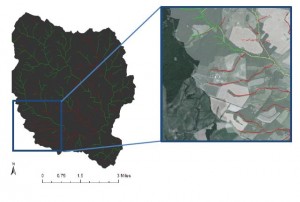Identify is a monthly series here on the SAL blog, focusing on students, faculty, and alumni of University of Richmond who have used GIS in exciting ways. Come by each month to learn more about the interdisciplinary nature of GIS here at UR.

One of the final maps produced by Holden and Kelso. Flow paths colored in red contribute more to the runoff in the Chesapeake Bay than do flow paths colored in green.
The Spatial Analysis Lab is an active place throughout the academic year—especially as we approach the end of the semester with students working diligently to finish their projects! But the SAL doesn’t remain dormant during the summer, and in fact stays equally active, thanks to the students who pursue geography- and environmental studies-related summer research.
Taylor Holden ’15 and Austen Kelso ’15 were among the students conducting research this previous summer. Working with their advisors, UR Geography professor Dr. Todd Lookingbill and Jeffrey Allenby of the Chesapeake Conservancy, these two students carried out a novel research project to determine locations of concentrated flow paths and their relative importance to water pollution in the Chesapeake Bay.Under the Clean Water Act, localities whose water runoff feeds into the Chesapeake Bay have to meet daily requirements for the maximum amount of nutrients and pollutants allowable in runoff, known as the “total maximum daily load”. Attaining these goals can be challenging, since localities not only have to identify major sources of water pollution but also must find ways to curb that pollution. Allenby recently wrote a procedure to achieve this end, and it was this procedure that Holden and Kelso carried out.
Using high-resolution aerial photography from the National Agriculture Imagery Program, Holden and Kelso first analyzed some small watersheds in Central Virginia. They then used an advanced remote sensing program called ENVI to classify these aerial images by various land cover types. This produced a raster image, similar to the National Land Cover Database rasters but with much more detail, that they could bring into ArcMap. Separately, they used precise digital elevation models and a specialty ArcGIS toolbar called TauDEM to find locations of concentrated flow paths, the exact places where runoff flows over land. Often these were permanently-existing streams, but the tool could also find ephemeral flow paths that lasted only during a rain storm, for instance.
Holden and Kelso then overlaid the flow paths with the land cover data in ArcMap. Presuming that certain land cover types (such as tilled agricultural land or impervious surfaces) contribute to nutrient runoff loads more than other land cover types (dense forest, for instance), they weighted the land cover types accordingly and intersected those weights with the flow path locations. Their resulting map of flow paths showed exactly where large amounts of pollutants were entering the watershed, and thus which exact parcels of land could be the best targets for pollutant remediation. Rather than trying to remedy runoff problems along all the many miles of flow paths in the Chesapeake Bay watershed, this method allows agencies to focus their efforts on specific, high-benefit areas.
For Allenby and the Chesapeake Conservancy, this analysis was a proof of concept: not only that the method could successfully identify areas with disproportionately high quantities of pollution runoff, but also that college students could carry out this high-level analysis. Since then, the Chesapeake Conservancy has started to work with other universities throughout the Chesapeake Bay watershed in carrying out similar analyses.
For the two students, this project was rewarding, even though it was often challenging. Kelso, for instance, said learning how to use new software and new techniques were among the hardest aspects; “not only did we have to learn how to use these new softwares, but we had to learn them thoroughly enough to use them effectively and accurately to complete the project.”
But the rewards came from realizing that this project had real community value. “A lot of [academic] classes focus on large scale concepts,” said Holden. “But with this project we could look within a neighborhood.… This made the project feel so applicable because it was on a scale [where] we could potentially have a measurable impact.” Kelso agreed, adding, “I found this project to be very exciting because … our results would be used in real life decision-making processes in the Chesapeake Bay watershed.… It was a good reminder that what I am learning has useful real world applications.”
The Spatial Analysis Lab looks forward to continue working with the Chesapeake Conservancy, both to further this project for other local watersheds and to assist in future research projects. Such work demonstrates that while the SAL may be a great University of Richmond resource, its benefits extend far beyond our campus boundaries.